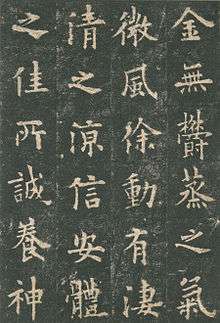Ouyang Xun

Ouyang Xun (Chinese: 歐陽詢; pinyin: Ōuyáng Xún; Wade–Giles: Ou-yang Hsun) (557–641), courtesy name Xinben (Chinese: 信本; pinyin: Xìn běn; Wade–Giles: Hsing-pên), was a Confucian scholar and calligrapher of the early Tang Dynasty. He was born in Hunan, Changsha, to a family of government officials; and died in modern Anhui province.
Achievements
He was a talented student who read widely in the classics. He served under the Sui Dynasty in 611 as Imperial Doctor. He served under the Tang Dynasty as censor and scholar at the Hongwen Academy. There he taught calligraphy. He was a principal contributor to the Yiwen Leiju.
He became the Imperial Calligrapher and inscribed several major imperial steles. He was good at regular script and his most famous work is the Stele in the Jiucheng Palace. He was considered a cultured scholar and a government official. Along with Yu Shinan, Xue Ji, and Chu Suiliang he became known as one of the Four Great Calligraphers of the Early Tang.
He notably wrote the inscription of the Kaiyuan Tongbao cash coin which became one of the most influential coins in Chinese history,[1][2] this coin also influenced the calligraphic styles of other coinages in Japan,[3] Sogdia,[4][5] and Vietnam.[6]
References
- ↑ "Chinese coins – 中國錢幣 § Tang Dynasty (618-907)". Gary Ashkenazy / גארי אשכנזי (Primaltrek – a journey through Chinese culture). 16 November 2016. Retrieved 9 June 2018.
- ↑ Hartill, David (September 22, 2005). Cast Chinese Coins. Trafford, United Kingdom: Trafford Publishing. ISBN 978-1412054669.
- ↑ Japan Mint History of Japanese Coins (for kids). Retrieved: 06 June 2018.
- ↑ "Samarqand's Cast Coinage of the Early 7th–Mid-8th Centuries AD: Assessment based on Chinese sources and numismatic evidence". Andrew Reinhard (Pocket Change – The blog of the American Numismatic Society). 12 August 2016. Retrieved 9 June 2018.
- ↑ "Soghdian Kai Yuans (lectured at the Dutch 1994-ONS meeting)". T.D. Yih and J. de Kreek (hosted on the Chinese Coinage Website). 1994. Retrieved 8 June 2018.
- ↑ The Asian Numismatic Museum (Sudokuone.com) Vietnamese Thien Tu and Kai Yuan Style - Thiên Tư Nguyên Bảo 天資元寶 Thư pháp, viết theo phong cách, Trung Quốc Kai Yuan by Dr. R. Allan Barker. Retrieved: 07 June 2018.
- Wang, Jingxian, "Ouyang Xun". Encyclopedia of China (Arts Edition), 1st ed.
External links
| Wikimedia Commons has media related to Ouyang Xun. |
- Gallery of Ouyang Xun at China Online Museum
- Resource Library Ouyang Xun — artnet.com.
- Yiwen Leiju "Collection of Various Matters from Classics and other Literature" — Chinaknowledge.de.
- Callygraphy during the Tang Dynasty Art Virtue